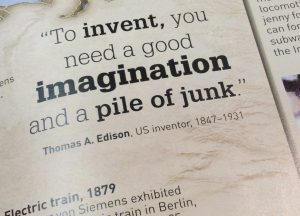Class 5 – How Can You Prototype Quickly?
This week’s class discussion:
- Introducing lo-fidelity prototyping

- Where it fits into iterative design
- When and why you would choose to do this
- Case studies: IDEO’s nasal surgery device; artificial heart valve; NASA augmented reality; Google glass
- How do you do it + good supplies
———————–
Between Part 1 & 2 exercise, we will have a breakout session to share what you designed and learned about your prototype
This week’s class activity about “How can you prototype quickly?”
Exercise 1 – Part 1: Choose a 6 lo-fi challenge:
- Portable tool carrier
- Umbrella/coat rack
- Portable work surface
- Moveable, reusable work surface
- Container that attaches to a chair to hold personal objects
- Welcome message display
Exercise 1 – Part 2: Plot Twist!
- Add the new interactivity requirement to your prototype (or begin again)
Due by the end of class:
- Upload photos of your final prototype to Canvas
Next week’s assignment:
Individually read:
Stephanie Houde and Charles Hill’s What Do Prototypes Prototype?
Caitlin Kalinowski’s 6 Steps to Superior Prototyping
Tom Chi: Home Team/Away Team
After completing the readings, please answer the following:
- What are some different approaches/methods for prototyping?
- What are some reasons a designer would choose one approach/method over another?
- You’re designing a therapeutic pet robot intended to be a companion for seniors with memory loss. The team working on this project is very opinionated—and made up of highly trained domain experts like gerontologists, mechanical engineers, and computer scientists who cannot agree on what form factor the robot should take on, interactivity and appropriate haptic feedback. As lead designer, what would you do? Who would be involved?

